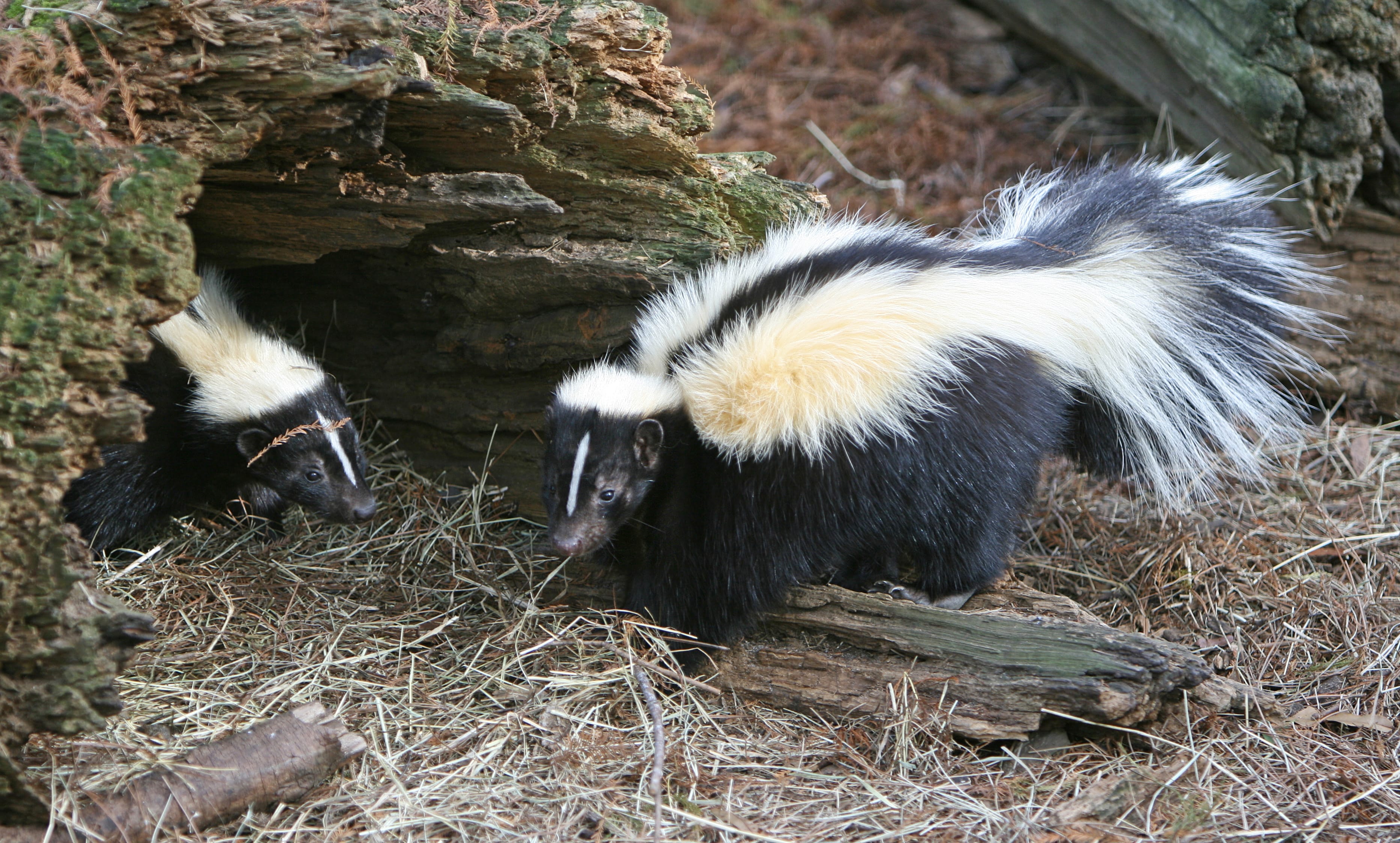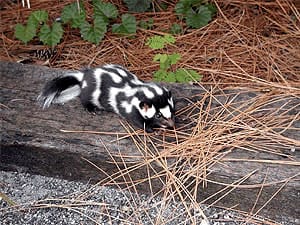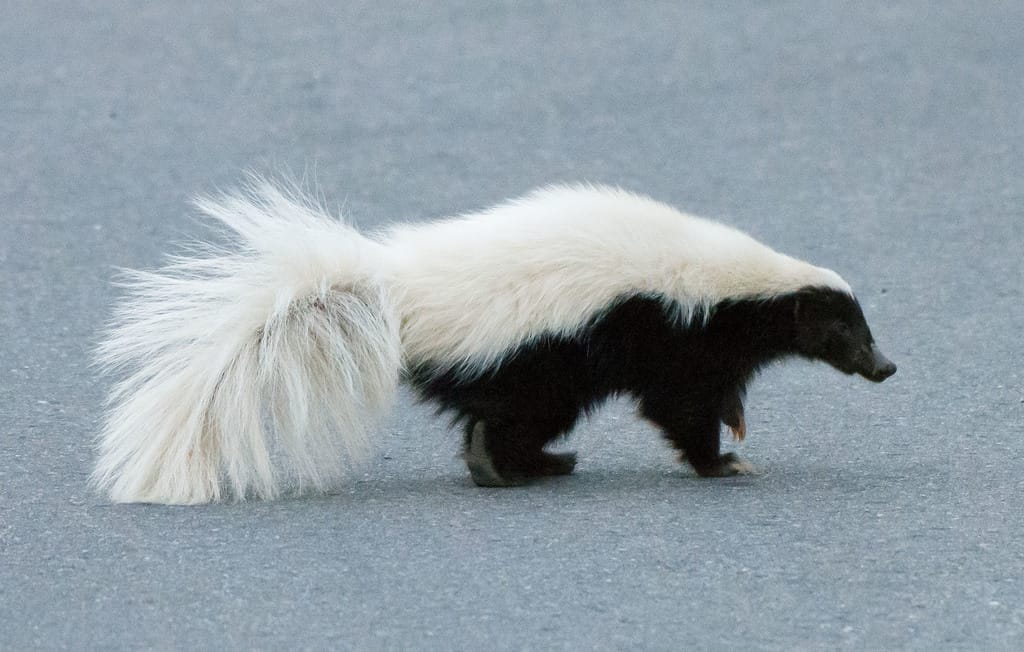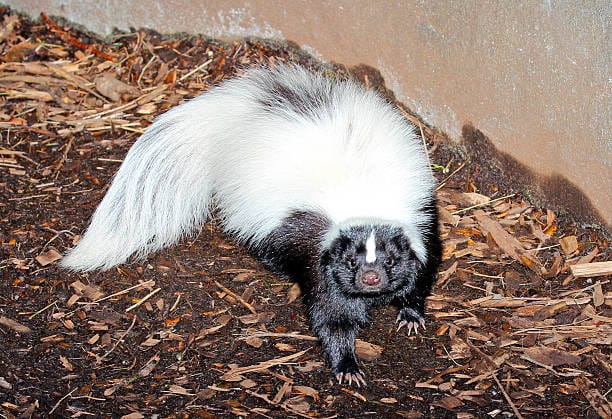Georgia is home to some of the most fascinating skunks in the United States. Whether you are wandering in the woodlands, strolling through suburban neighborhoods, or exploring farmland, you might encounter these nocturnal creatures. Skunks are known for their distinctive black-and-white coats and powerful scent defense, but beyond the spray lies an intriguing world of behavior, adaptations, and ecology. In this article, we explore the five types of skunks found in Georgia, their habitats, diets, and interactions with humans, offering a detailed guide for both wildlife enthusiasts and curious beginners alike.
Types of Skunks in Georgia
1. Striped Skunk (Mephitis mephitis)

Fun fact: The striped skunk’s iconic stripes aren’t just for show—they warn predators of its potent spray.
Physical Characteristics & Identification Tips
The striped skunk is medium-sized, usually 20-31 inches long including its bushy tail, and weighs between 2.5–14 pounds. Its glossy black fur is adorned with two bold white stripes extending from the head to the tail. Juveniles may display broken or irregular stripes. Distinguishing them from other skunks is relatively straightforward due to their bold coloration and size.
Behavior
Primarily nocturnal, striped skunks forage at night and are known for their slow, deliberate movements when threatened. Their signature defensive posture involves stamping their feet, raising their tail, and delivering a powerful, sulfurous musk if provoked. Social interactions are minimal outside mating season, and they often communicate through scent marking and vocalizations such as hisses and growls.
Habitat and Range
Striped skunks occupy diverse habitats ranging from forests, grasslands, and wetlands to suburban areas and farmlands. They construct burrows or adopt abandoned dens from other animals and are highly adaptable to human-modified landscapes. In Georgia, they are widespread throughout the state.
Diet
These omnivores have a varied diet including insects, small mammals, birds’ eggs, fruits, and even carrion. Their diet shifts seasonally, consuming more plant matter during fall and winter when insects are scarce. Skunks play a critical role in controlling insect populations, especially beetles and grasshoppers.
Reproduction and Life Cycle
Breeding occurs from February to March. After a gestation period of approximately 60–77 days, females give birth to 4–7 kits in a secluded den. Young are weaned around two months of age and begin foraging with the mother. Lifespan in the wild averages 3 years, though some can reach 7 years under ideal conditions.
Fun Facts / Unique Traits
Striped skunks can accurately spray their musk up to 10 feet. They are excellent diggers and swimmers, often foraging in moist soil for grubs. Despite their fierce defense mechanism, they are generally gentle animals that avoid unnecessary confrontation.
Human Interaction
Skunks frequently come into contact with humans due to their adaptability. They can become nuisances when they dig gardens or leave droppings, but they are largely beneficial by reducing pests. Proper precautions like securing garbage and avoiding cornering skunks can prevent negative encounters.
2. Eastern Spotted Skunk (Spilogale putorius)

Fun fact: Known for its acrobatic spray warning, the Eastern Spotted Skunk often performs handstands before spraying.
Physical Characteristics & Identification Tips
The Eastern Spotted Skunk is smaller than its striped cousin, measuring 14–21 inches in length with a weight of 1–3 pounds. Its fur is black with broken white stripes and spots, giving it a dappled appearance. This species’ slender body and long tail make it agile and capable of climbing low branches.
Behavior
Mostly nocturnal and solitary, Eastern Spotted Skunks are excellent climbers and show remarkable agility. When threatened, they can rear up on their front legs and wag their tail to warn predators before releasing a concentrated spray. Unlike striped skunks, they are less likely to wander into suburban areas.
Habitat and Range
This skunk prefers mixed woodlands, open fields, and brushy areas, often near water sources. They may den in hollow logs, rock crevices, or abandoned burrows. Eastern Spotted Skunks are scattered across northern and central Georgia, with populations smaller than striped skunks.
Diet
The diet primarily consists of insects, small rodents, birds’ eggs, fruits, and berries. They are particularly adept at hunting insects, using their nimble paws and climbing skills to access hidden prey.
Reproduction and Life Cycle
Breeding occurs in late winter with gestation lasting about 60–77 days. Litters are smaller than striped skunks, usually 2–6 kits. The young are dependent on their mother for the first eight weeks, gradually learning foraging skills.
Fun Facts / Unique Traits
Spotted skunks are known for their acrobatic defensive display. They are also highly selective in their denning locations and rarely become nuisances to humans due to their secretive nature.
Human Interaction
While less commonly seen, Eastern Spotted Skunks contribute to natural pest control. Observing them from a distance is recommended; their spray is even more potent than that of striped skunks.
3. Hooded Skunk (Mephitis macroura) – Rare / Vagrant

Fun fact: The hooded skunk’s long “hooded” white stripe gives it an elegant, almost regal look among skunks.
Physical Characteristics & Identification Tips
Slightly smaller than striped skunks, the hooded skunk has an elongated white stripe running from the head along the back, creating a hood-like appearance. Adults typically measure 18–25 inches and weigh 2–6 pounds. Their long tail and narrow body distinguish them from other skunks in Georgia.
Behavior
Hooded skunks are nocturnal and secretive, avoiding human settlements. They forage on the ground and in low vegetation, and their musk is deployed only when cornered. Social interactions are limited to mating season.
Habitat and Range
Rarely observed in Georgia, hooded skunks are typically seen near the southern border, occasionally venturing from Florida. They prefer forest edges, scrublands, and wetlands. Dens are usually in burrows or dense vegetation.
Diet
Omnivorous by nature, hooded skunks feed on insects, small vertebrates, fruits, and seeds. Their diet is similar to striped skunks but with more insect focus due to their smaller size and agility.
Reproduction and Life Cycle
Breeding occurs in late winter, with females giving birth to 3–5 kits. Young are weaned after approximately two months and quickly learn to forage independently.
Fun Facts / Unique Traits
Hooded skunks are excellent climbers and swimmers. They rarely spray humans due to their shy nature, relying on escape rather than confrontation.
Human Interaction
Interactions are minimal given their rarity. Sightings are considered special among wildlife enthusiasts and are usually photographed rather than approached.
4. Hog-nosed Skunk (Conepatus leuconotus) – Rare Visitor

Fun fact: True to its name, the hog-nosed skunk has an elongated snout that allows it to root through soil like a miniature pig.
Physical Characteristics & Identification Tips
The hog-nosed skunk is a robust skunk species measuring 20–28 inches in length, with a tail of about 7–12 inches. It weighs between 3–7 pounds. Its coloration is generally black with a single white stripe starting from the top of its head and running along the back. Unlike the striped skunk, its nose is more pronounced and flexible, aiding in digging and foraging for insects and roots.
Behavior
Primarily nocturnal, hog-nosed skunks are exceptional diggers. Their long snouts allow them to excavate insect larvae, grubs, and other invertebrates hidden in the soil. When threatened, they adopt a defensive posture similar to other skunks but rely on their agility and digging ability to escape from predators. They are solitary animals except during mating season.
Habitat and Range
Hog-nosed skunks are not commonly found in Georgia but may occasionally venture into southern parts of the state. Their preferred habitats include dry open fields, scrublands, and forest edges. They often make temporary burrows or take over abandoned dens of other animals. Proximity to water sources is less critical for them than for other skunks.
Diet
These skunks are omnivores with a strong preference for insects, especially beetle larvae and grubs, which they locate by rooting in the soil. They also consume small rodents, amphibians, fruits, and occasionally eggs. Seasonal dietary shifts may occur when insects are scarce in winter months, leading them to rely more on plant matter and small vertebrates.
Reproduction and Life Cycle
Breeding typically occurs in late winter, with gestation lasting about 60 days. Females give birth to 3–5 kits in underground dens. Young are weaned after 6–8 weeks and gradually learn to forage under the watchful eye of their mother. Lifespan in the wild averages 3–5 years, though predation and human activity can reduce survival.
Fun Facts / Unique Traits
Hog-nosed skunks are incredible diggers, and their nose is flexible and sensitive enough to detect subterranean prey. Unlike other skunks, they are more likely to flee than spray when confronted. Their solitary nature makes sightings rare, which is part of their mystique in Georgia’s wildlife community.
Human Interaction
Due to their rarity, hog-nosed skunks seldom interact with humans. Gardeners and farmers may occasionally spot them when digging through soil or foraging for insects. While their spray is potent, it is used sparingly, making accidental encounters less dramatic than with other skunks.
5. Western Spotted Skunk (Spilogale gracilis) – Vagrant / Occasional Sighting

Fun fact: The Western Spotted Skunk is one of the most acrobatic skunks, capable of performing handstands as part of its defensive display.
Physical Characteristics & Identification Tips
Smaller and more agile than the striped skunk, the Western Spotted Skunk measures 14–21 inches with a weight of 1–3 pounds. Its fur is black adorned with broken white stripes and spots across the back and flanks. Its slender frame and elongated tail help distinguish it from Eastern spotted skunks and striped skunks.
Behavior
Primarily nocturnal, Western Spotted Skunks are elusive and secretive. They are known for their dramatic defensive display, which includes standing on forelegs and wagging their tail to signal warning before releasing a highly concentrated spray. This species is more arboreal than other skunks, sometimes climbing low branches or shrubs in search of insects.
Habitat and Range
Although native to western parts of North America, Western Spotted Skunks occasionally appear in western Georgia as rare vagrants. They prefer open woodlands, scrublands, and forest edges. Dens are often in rock crevices, hollow logs, or abandoned burrows, providing protection from predators and harsh weather.
Diet
Western Spotted Skunks are opportunistic omnivores. Their diet includes insects, small rodents, birds’ eggs, fruits, and berries. Their climbing ability allows them to reach insect-rich areas in shrubs or low tree branches. Seasonal shifts in diet help them survive through harsh winters.
Reproduction and Life Cycle
Breeding occurs in late winter, with gestation lasting approximately 60–70 days. Females give birth to 2–6 kits, which remain in the den for the first two months of life. Young gradually learn to forage alongside their mother and reach independence by three months.
Fun Facts / Unique Traits
The Western Spotted Skunk’s acrobatic defense is unparalleled among skunks. It is also highly secretive, which makes spotting one a rare and exciting experience for wildlife enthusiasts. They are fast, agile, and skilled climbers, distinguishing them from other ground-dwelling skunks.
Human Interaction
Encounters with humans are extremely rare. When sightings occur, they are generally brief and non-confrontational. Their shy nature and agility mean they usually escape quickly without deploying their spray, making them intriguing but unobtrusive members of Georgia’s wildlife.
Frequently Asked Questions About Skunks in Georgia
1. What types of skunks are commonly found in Georgia?
Georgia is home to several skunk species, including the Striped Skunk, Eastern Spotted Skunk, Hog-nosed Skunk, Western Spotted Skunk, and occasionally the Hooded Skunk. Each species has distinct markings and behaviors that make them unique residents of the state.
2. Are striped skunks native to Georgia?
Yes, the Striped Skunk is native to Georgia and is the most commonly encountered species across urban, suburban, and rural areas.
3. How many species of skunks live in Georgia?
Georgia hosts at least five different skunk species, each with unique physical characteristics, behaviors, and habitat preferences.
4. What habitats do skunks prefer in Georgia?
Skunks in Georgia thrive in a variety of habitats, including woodlands, grasslands, farmlands, and suburban areas with access to food, water, and shelter.
5. Are spotted skunks found in Georgia?
Yes, both Eastern and Western Spotted Skunks can be found in Georgia, although they are less common than the Striped Skunk and are often more elusive.
6. How can I identify skunks in Georgia?
Skunks in Georgia can be identified by their distinct coloration and markings. Striped Skunks have bold black-and-white stripes, while Spotted Skunks have broken or spotted white patterns. Hog-nosed Skunks have a characteristic elongated nose.
7. What do skunks in Georgia eat?
Georgia skunks are omnivorous. They feed on insects, small mammals, birds’ eggs, fruits, berries, and even human food scraps in urban areas.
8. Do skunks in Georgia hibernate during winter?
Skunks in Georgia do not truly hibernate. Instead, they enter periods of torpor, reducing activity during cold spells while foraging opportunistically when weather permits.
9. Are skunks in Georgia dangerous to humans?
Skunks in Georgia are generally non-aggressive but can spray a foul-smelling liquid if threatened. They can also carry diseases like rabies, so it’s wise to avoid close contact.
10. How do skunks in Georgia reproduce?
Skunks in Georgia breed in late winter to early spring. Females give birth to 2–6 kits after a gestation of approximately 60–70 days. Young remain in the den for several weeks before learning to forage.
11. Can skunks in Georgia carry diseases?
Yes, skunks in Georgia can carry diseases such as rabies, leptospirosis, and parasites. Vaccinations for pets and cautious wildlife interaction are recommended.
12. What time of day are skunks in Georgia most active?
Skunks in Georgia are primarily nocturnal, emerging at dusk to forage and returning to dens before sunrise.
13. How do people in Georgia deal with skunk encounters?
Residents typically avoid skunks, secure garbage bins, and limit food availability outdoors. Humane trapping and relocation by professionals are common for persistent skunks.
14. Are hog-nosed skunks found in Georgia?
Yes, although they are rare. Hog-nosed Skunks are primarily found in southern parts of Georgia and prefer open fields and scrub habitats.
15. What is the lifespan of skunks living in Georgia?
In the wild, skunks in Georgia live around 3–5 years, though predation, disease, and human-related factors can shorten this lifespan.
16. How do skunks in Georgia interact with other wildlife?
Skunks in Georgia are generally solitary but may share habitats with raccoons, opossums, and foxes. They avoid conflict but can be opportunistic predators of small animals.
17. Can skunks in Georgia climb trees or structures?
Spotted skunks are capable climbers and may scale low trees or fences to access food, whereas striped skunks mostly remain on the ground.
18. Are there any conservation concerns for skunks in Georgia?
Currently, most skunk populations in Georgia are stable. However, habitat loss and vehicle collisions can impact local populations, making responsible wildlife management important.
Conclusion
Skunks in Georgia are more than their defensive spray. From the common striped skunk to the rare hooded and vagrant species, they play essential roles in controlling pests and maintaining ecological balance. Observing skunks offers insights into nocturnal behavior, diet adaptation, and the subtle ways wildlife interacts with humans. Respecting their space ensures safe coexistence while enjoying the unique charm of these fascinating mammals. Georgia’s skunks demonstrate adaptability, intelligence, and the understated elegance of creatures that thrive at night.
Read more: 35 Types of Grasshoppers (With Pictures and Identification)
